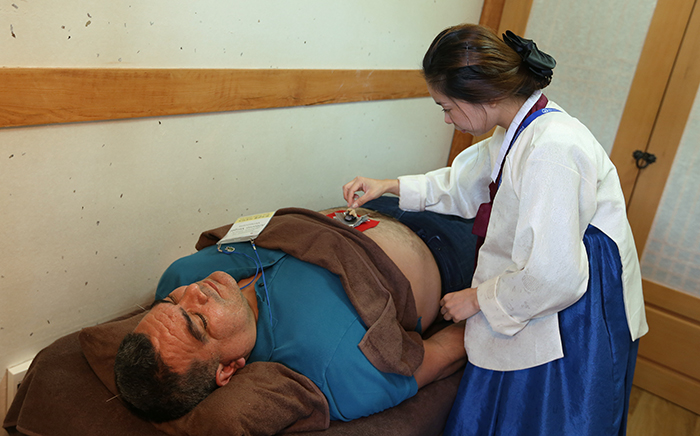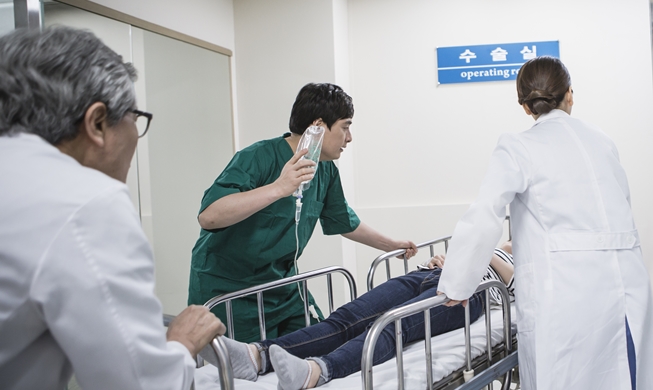The Korean healthcare system will expand its insurance coverage to include more traditional Korean medicine treatments.
Previously, patients were only able to get insurance coverage for acupuncture, ddeum, a method of treatment where moxa, a type of plant, is burned on the skin, and buhang, or cupping. The expanded list will now include treatments such as movement therapy, traditional physiotherapy and chuna, a type of chiropractic treatment.

On Jan. 13, the Ministry of Health and Welfare's Committee for the Promotion and Advancement of Traditional Korean Medicine decided to expand national insurance coverage to include traditional treatments. It also proposed a plan for the development of a standardized set of clinical practice guidelines, part of the Third Comprehensive Plan for the Promotion and Advancement of Traditional Korean Medicine.
The plan expands previously limited health coverage for traditional medicines to now cover treatments such as movement therapy, traditional physiotherapy and chuna. The plan allocates insurance coverage for common ailments and establishes insurance criteria for traditional medication. It assigns a budget for R&D that focuses on innovation and development of a scientific method for traditional Korean medicine. The plan also encourages practitioners to replace mixed medical herbs with pharmaceutically prepared medication in the form of pills and syrups. The hope is that the proposed changes in prescription methods will open doors for the export of traditional medication.
The development of a scientific method also extends to the standardized set of clinical practice guidelines for traditional Korean medicine.
The plan outlines a five-year program whereby a standardized set of clinical practice guidelines will be developed for 30 major ailments, such as the common cold, Alzheimer's disease and cancer. For this purpose, an information center will be set up where a three-year clinical research project will be carried out for each ailment. The center will be responsible for the administration, dissemination and renewal of the clinical practice guidelines.
The ministry will be investing KRW 48 billion to support this five-year project, raising its investment by 6 percent each year. The funds will be used for the development of new traditional medications, for research into standardized clinical practice guidelines and to help the convergence between Western and traditional Korean medical practices.
Vice Minister of Health and Welfare Bang Moon-kyu, who is also chairman of the committee, stated that the ministry will "cooperate with the traditional Korean medicine sector and with other government departments, and convene the committee every year to evaluate progress of the proposed programs."
By Lee Hana
Korea.net Staff Writer
Photo: Korea.net
hlee10@korea.kr
Previously, patients were only able to get insurance coverage for acupuncture, ddeum, a method of treatment where moxa, a type of plant, is burned on the skin, and buhang, or cupping. The expanded list will now include treatments such as movement therapy, traditional physiotherapy and chuna, a type of chiropractic treatment.

The Ministry of Health and Welfare is expanding its national health insurance to cover traditional Korean medicine and is developing standardized clinical practice guidelines.
On Jan. 13, the Ministry of Health and Welfare's Committee for the Promotion and Advancement of Traditional Korean Medicine decided to expand national insurance coverage to include traditional treatments. It also proposed a plan for the development of a standardized set of clinical practice guidelines, part of the Third Comprehensive Plan for the Promotion and Advancement of Traditional Korean Medicine.
The plan expands previously limited health coverage for traditional medicines to now cover treatments such as movement therapy, traditional physiotherapy and chuna. The plan allocates insurance coverage for common ailments and establishes insurance criteria for traditional medication. It assigns a budget for R&D that focuses on innovation and development of a scientific method for traditional Korean medicine. The plan also encourages practitioners to replace mixed medical herbs with pharmaceutically prepared medication in the form of pills and syrups. The hope is that the proposed changes in prescription methods will open doors for the export of traditional medication.
The development of a scientific method also extends to the standardized set of clinical practice guidelines for traditional Korean medicine.
The plan outlines a five-year program whereby a standardized set of clinical practice guidelines will be developed for 30 major ailments, such as the common cold, Alzheimer's disease and cancer. For this purpose, an information center will be set up where a three-year clinical research project will be carried out for each ailment. The center will be responsible for the administration, dissemination and renewal of the clinical practice guidelines.
The ministry will be investing KRW 48 billion to support this five-year project, raising its investment by 6 percent each year. The funds will be used for the development of new traditional medications, for research into standardized clinical practice guidelines and to help the convergence between Western and traditional Korean medical practices.
Vice Minister of Health and Welfare Bang Moon-kyu, who is also chairman of the committee, stated that the ministry will "cooperate with the traditional Korean medicine sector and with other government departments, and convene the committee every year to evaluate progress of the proposed programs."
By Lee Hana
Korea.net Staff Writer
Photo: Korea.net
hlee10@korea.kr
Most popular
- Korea.net welcomes 2025 K-influencers, Honorary Reporters
- 2025 Honorary Reporter class pledges to spread 'real Korea' worldwide
- Actor Bae Doona's first romcom in decade to hit theaters in May
- US urged to exempt tariffs on Korea in first '2+2' trade talks
- 'Gangnam Style,' 'Baby Shark' make YouTube's 2005-25 best list
